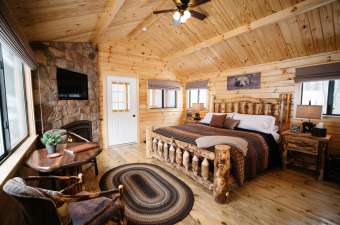Fallingwater is among a group of 10 buildings designed by Frank Lloyd Wright (1867-1959), widely considered to be the greatest American architect of the 20th century, to become the first works of modern architecture nominated by the United States to the United Nations Educational, Scientific and Cultural Organization (UNESCO) World Heritage List.
The buildings—Unity Temple in Oak Park, Illinois; Frederick C. Robie House in Chicago, Illinois; Taliesin in Spring Green, Wisconsin; Hollyhock House in Los Angeles, California; Fallingwater in Mill Run, Pennsylvania; Herbert and Katherine Jacobs House in Madison, Wisconsin; Taliesin West in Scottsdale, Arizona; Solomon R. Guggenheim Museum in New York City; Price Tower in Bartlesville, Oklahoma; and Marin County Civic Center in San Rafael, California—were built between 1906–1969 and chosen for their significance in the development of modern architecture. They are the most iconic, fully realized and innovative of more than 400 existing works by Frank Lloyd Wright. Each is a masterwork and together they show varied illustrations of “organic architecture” in their abstraction of form, use of new technologies and masterful integration of space, materials and site. All have been designated U.S. National Historic Landmarks.
Throughout his career, Wright expressed organic architecture by integrating buildings with the natural world, melding form with space to create spatial drama. Inspired by nature and technology and seeking an alternative to European models, he used materials and structural forms in often new and innovative ways that relate to the geographically diverse United States.
“Wright was the father of modern architecture, fundamentally redefining the nature of form and space during the early 20th century in ways that would have enduring impact on modern architecture worldwide,” says Richard Longstreth, director of the graduate program in historic preservation at George Washington University and president of the Frank Lloyd Wright Building Conservancy. The Conservancy, an organization dedicated to preserving the extant work of Wright, appointed an advisory committee of experts in 2003 to select the group of Wright buildings. It prepared the nomination through intensive collaboration with representatives from each of the 10 Wright sites and in consultation with the Office of International Affairs of the National Park Service.
Lynda Waggoner, director of Wright’s internationally acclaimed Fallingwater, coordinated all aspects of preparation of the nomination dossier, entitled Key Works Modern Architecture by Frank Lloyd Wright. “It is a complex nomination that explains the significance of each building and its outstanding universal value,” says Waggoner. “We had to demonstrate how each represents a masterpiece of human creative genius and is an extraordinary contribution to modern architecture and culture.”
Inscription to the List, which will be considered by UNESCO’S World Heritage Committee, could be decided in the summer of 2016 after a series of site visits during 2015. Inclusion in the List would mean the buildings and their sites are identified as being of outstanding value not only in their own country but to the global community and therefore must be preserved as part of the world heritage of mankind as a whole. The UNESCO honor would provide no specific protections but the designation draws international attention to these sites.
Only 22 of the more than 1,000 World Heritage Sites worldwide are located in the United States, where the few inscribed works of architecture include Independence Hall and Monticello. The Wright works would join the Sydney Opera House, the city of Brasilia, the Bauhaus School in Germany and the works of Antoni Gaudí as some of the examples of modern architecture recognized on the international list.
More information on the U.S. nomination to the World Heritage List can be found at the U.S. Department of the Interior: http://www.doi.gov/news/pressreleases/index.cfm
About the Western Pennsylvania Conservancy:
The Western Pennsylvania Conservancy (WPC) enhances the region’s quality of life by protecting and restoring exceptional places. A private nonprofit conservation organization founded in 1932, WPC has helped to establish ten state parks, conserved more than 235,000 acres of natural lands and protected or restored more than 1,500 miles of rivers and streams. The Conservancy owns and operates Fallingwater, which symbolizes people living in harmony with nature. In addition, WPC enriches our region’s cities and towns through 130 community gardens and other green spaces that are planted with the help of about 12,500 volunteers. The work of the Western Pennsylvania Conservancy is accomplished through the support of nearly 10,000 members. For more information, visit WaterLandLife.org.
About Fallingwater (1935, Mill Run, Pennsylvania):
Fallingwater is among the world’s best-known private residences. An astonishing construction and a consummate example of the union of architecture and nature, the house was designed as a series of three horizontal trays (floors), stacked one upon the other that appear to soar with no support, outward over a 30-foot waterfall below. Fallingwater masterfully integrates reinforced concrete, steel, and glass—along with the natural materials of wood and native stone—to create a unique building whose daring cantilevered construction stretched the limits of design and technology of the period. Fallingwater is also an astonishing expression of its physical site: the house cascades down the hillside like the water over the rocks below. Today the house is a museum operated by the Western Pennsylvania Conservancy.








